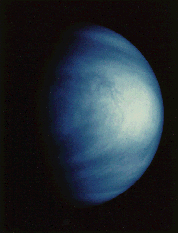
Note: Click on Solar System Exploration: Galileo Legacy Site (NASA-JPL) to get this image at its highest resolution.
Colorized picture of Venus through a violet filter.
Only the uppermost clouds, about 60-70 kilometers (36-42 miles) above the
surface, are visible at this wavelength.
This picture of Venus was (appropriately, for a planet named for the
goddess of Love) taken on February 14, 1990, from a distance of almost
2.84 million kilometers (1.7 million miles), about 6 days after Galileo's
closest approach to the planet.
The image has been colorized to a bluish hue to emphasize subtle contrasts
in the cloud marking and to indicate that it was taken through a violet
filter.
Features in the sulfuric acid clouds near the top of the planet's
atmosphere are most prominent in violet and ultraviolet light.
This image shows the general trend of cloud bands that stretch along the
east-west direction (North is at the top, and the evening terminator is
on the left, so East is to the left), and the brighter polar "hoods,"
features that had been seen in previous Venus observations.
All of these features are embedded in winds that flow from east to west at
a speed of about 380 kilometers per hour (230 miles per hour).
The smallest features visible are about 75 kilometers (45 miles) across.
The bright white-colored region on the planet's right side is the
"subsolar point," where the sun shines down directly on the planet's
surface (i.e. if you were standing at that point on Venus, the Sun
would be directly overhead, and your watch, calibrated to Venusian time,
would tell you that it was 12 noon).
Note the dark spider-shaped pattern that is just to the left of the area;
scientists are still unsure as to the exact nature of this pattern, though
one possibility is that it's a storm system.
Next slide: Images of Earth
Back to: Galileo To Jupiter
Link to: Solar System Exploration: Galileo Legacy Site (NASA - JPL)
Updated: July 30 '96
Best seen with MS Internet Explorer.
Back: ARVAL - Image Gallery
Messages: